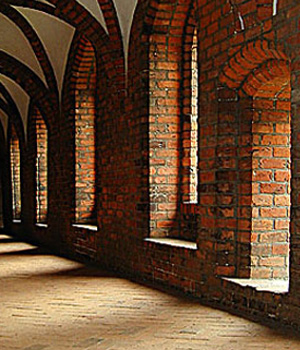| Karmeliterklosteret

| | Erik af Pommern anlægger allerede i 1410 et karmeliterkloster i Landskrona og i 1430 påbegyndtes opførelsen af Vor Frue Kloster i Helsingør, det mest velbevarede klosteranlæg i Norden. |
Med byudviklingen i løbet af middelalderen følger også anlæggelsen af en række klostre for forskellige tiggermunkeordener. Tiggermunkene skulle tage bolig i byerne og tjene til livets ophold ved almisser og gode gerninger og i det hele taget leve enkelt og forbilledligt. Allerede i 1200-tallet kommer Franciskanerordenen og Dominikanerordenen til landet og under Erik af Pommern kommer også Karmeliterordenen til området.
Karmeliterordenen har ifølge overleveringerne sit udspring blandt eremitter, der holdt til omkring Karmelbjerget i Det hellige Land. Ordenen opnår først endelig anerkendelse som tiggerorden af pave Johannes d.12. i 1326, hvor den dog allerede er etableret rundt omkring i Vesteuropa. Karmelitermunkene var som regel veluddannede, og kongens hensigt med at understøtte ordenen har bl.a. været, at de skulle medvirke til at skabe uddannelse og lærdom i byerne. Karmelitermunkene tiltænkes også en rolle i udviklingen af Københavns Universitet, der er anlagt i 1497, og i denhen seende skænker kongen dem i 1516 et kollegium i København,
"... hvorved samme kollegium og universitet her i staden kan forøges og forbedres, således at det på alle måder kan blive nyttigt og gavnligt for deres klostres brødre og andre studenter, som kommer og studerer her iKøbenhavn"

Byklostre | 
Karmelitermunk |
Klosteret oprettes
Allerede 1410 anlægges et karmeliterkloster i den nye købstad Landskrona og omkring 1430 påbegyndes opførelsen af Vor Frue Kloster i Helsingør, i daglig tale: Karmeliterklosteret, hvor Erik af Pommern skænker en grund og paven i 1431 giver sit samtykke. I 1450 udsættes klosteret for brand, men genopbygges, så det er i funktion igen omkring år 1500. Det smukke senmiddelalderlige klosteranlæg, der står endnu, er det bedst bevarede klosteranlæg i Norden.
Kongemagten understøtter udviklingen, men klostrene i byen kan i lighed med landklostrene også beriges ved sjælegaver. Jens Truelsön skænker f.eks. i 1469 Vor Frue Kloster en sådan sjælegave.
Poul Laxmands gaver
Tilkøb af sjælemesser er en slags afladshandel, men også en gensidig forpligtende forretning, således som det fremgår af en brevveksling vedrørende Povl Laxmand, der var lensmand på Krogen, eller "høvedsmand på Krogen på rigets vegne", som det hedder i en skrivelse fra 1482. I brevet opregner den øverstbefalende for Jomfru Maria Ordens Kloster i Danmark, Niels Christiernssøn, og den lokale prior, broder Godekær, hvad Povl Laxmand får for sin pengegave.
Hundrede lybske mark er det beløb, som Poul Laxmand har skænket til klosteret til gengæld for den pågældende tjenesteydelse. Det bliver tilsyneladende til en årlig donation, idet det i et brev fra 1493, altså 10 år senere siges, at Poul Laxmand har skænket:
"...ni 100 hundrede lybske mark danske penninge, for hvilke penge vort klosters kirke og omgang blev opbygget med flere gode folks hjælp".
Rigshofmesteren Poul Laxmand
Poul Laxmand er i slutningen af 1400 tallet,næst efter kongen, rigets største jordejer, som råder over indtægterne fra omkring 700 bøndergårde og endvidere besidder rigets højeste embede som rigshofmester, bindeleddet imellem kongen og rigsrådet. I 1497 myrdes Poul Laxmand under mystiske omstændigheder på åben gade i København og kong Hans konfiskerede hans ejendomme, idet han hævdede at Laxmand havde begået forræderi.
Poul Laxmand begraves i Vor frue Kirke i Helsingør og Laxmand-familiens våbenskjold figurer flere steder i klosteret, hvor det også lægger navn til kapitelsalen, den såkaldte Laxmandsal. I korbuen over højalteret ses Poul Laxmands familievåben på fædrene side svanen med guldring i næbbet og modsat Brahefamiliens slægtsvåben på mødrene side. Våbnene flankerer den korsfæstede Kristus og efterlader ingen tvivl om, hvem der har sat sit præg på kirken.

Poul Laxmands |
Poul Helgesen
Karmelitermunken Poul Helgesen, født i Varberg i Halland, er i 1517 knyttet til klosteret i Helsingør og bliver i 1519 rektor for kollegiet i København, underviser ved universitetet og er i perioden 1522-1534 provinsialleder for karmeliterne i Norden, provinsen Dacia kaldet. Poul Helgesen blev i tiden op til reformationen i 1536 den katolske kirkes bannerfører, men var samtidig tilhænger af en reformering af kirken og kristendommen. Han var i så henseende under stærk påvirkning af humanisten Erasmus af Rotterdam og en afhandling fra 1528 om årsagerne til fattigdom giver en smagsprøve på den forbavsende humanisme, der præger hans indstilling.
Reformationens følger
Poul Helgesen forsvinder ud af billedet før reformationen i 1536, men hans Skibbykrønike der blev fundet i 1650, er det vigtigste historiske værk fra reformationstiden. Klosteret i Helsingør ophører med at eksistere efter reformationen, idet det i 1541 er forvandlet til hospital for syge og fattige. I Helsingør tyder det på, at tidligere munke er endt som tiende- og almisseopkrævere for hospitalet, et hverv som de unægtelig havde forudsætninger for at bestride.
Der er her tilsyneladende tale om en blid overgang, hvor de gamle munke får lov til at forblive på stedet til deres død, eller på en eller anden måde tilpasser sig de nye omstændigheder. En skrivelse fra 1560 med tilknytning til Helsingør beretter nærmere, hvordan man tog på sagerne:
"Anders Ibsen, fordum abbed i Æbelholt, indgiver sig i Helsingør Hospital med alt sit gods, deriblandt også Blidstrup, Helsinge, Vejby og Kregme kongetiender, som han har i forlening i sin livstid efter Christian d.III.s brev."

Skibby Krøniken |
|